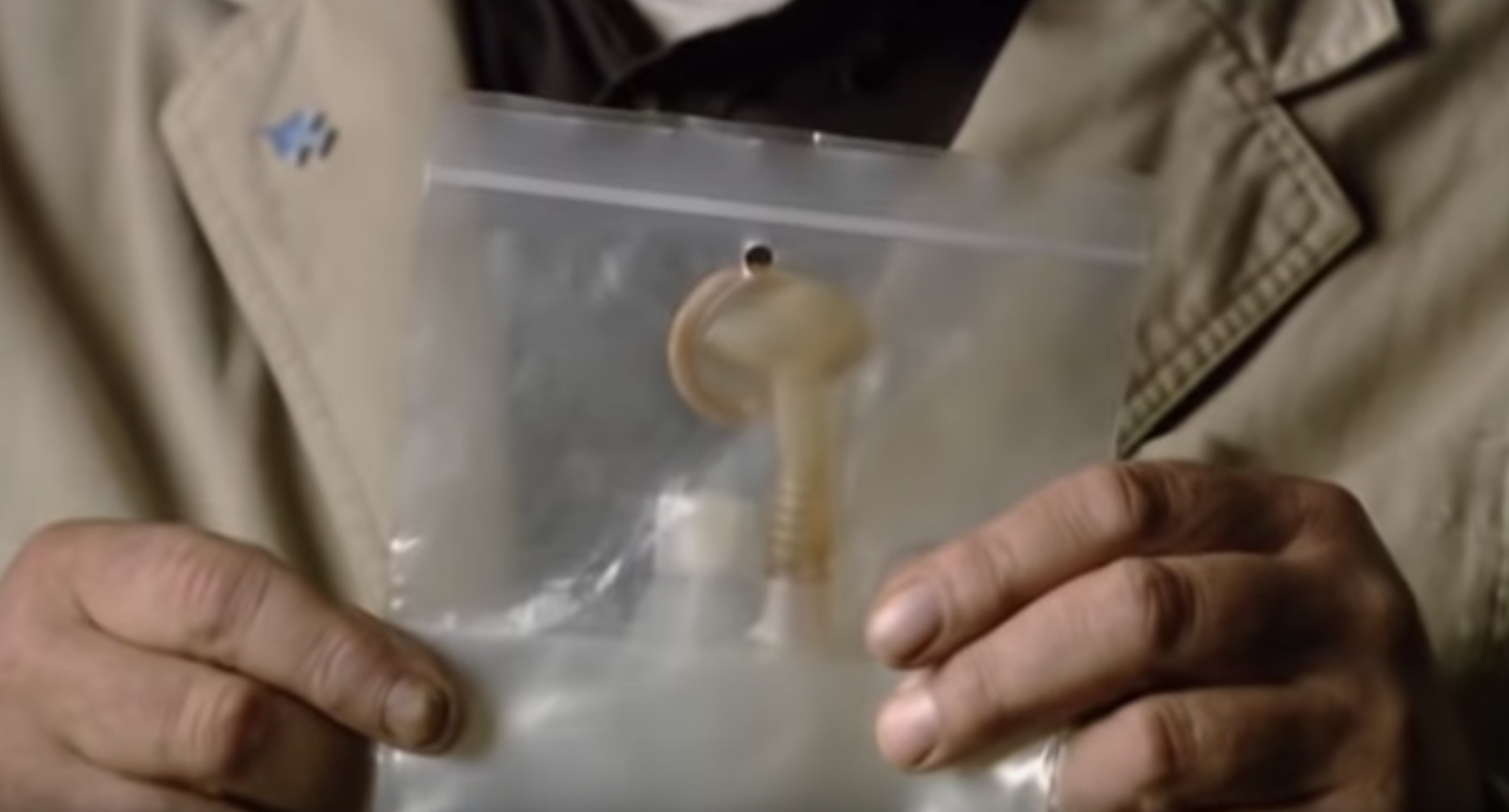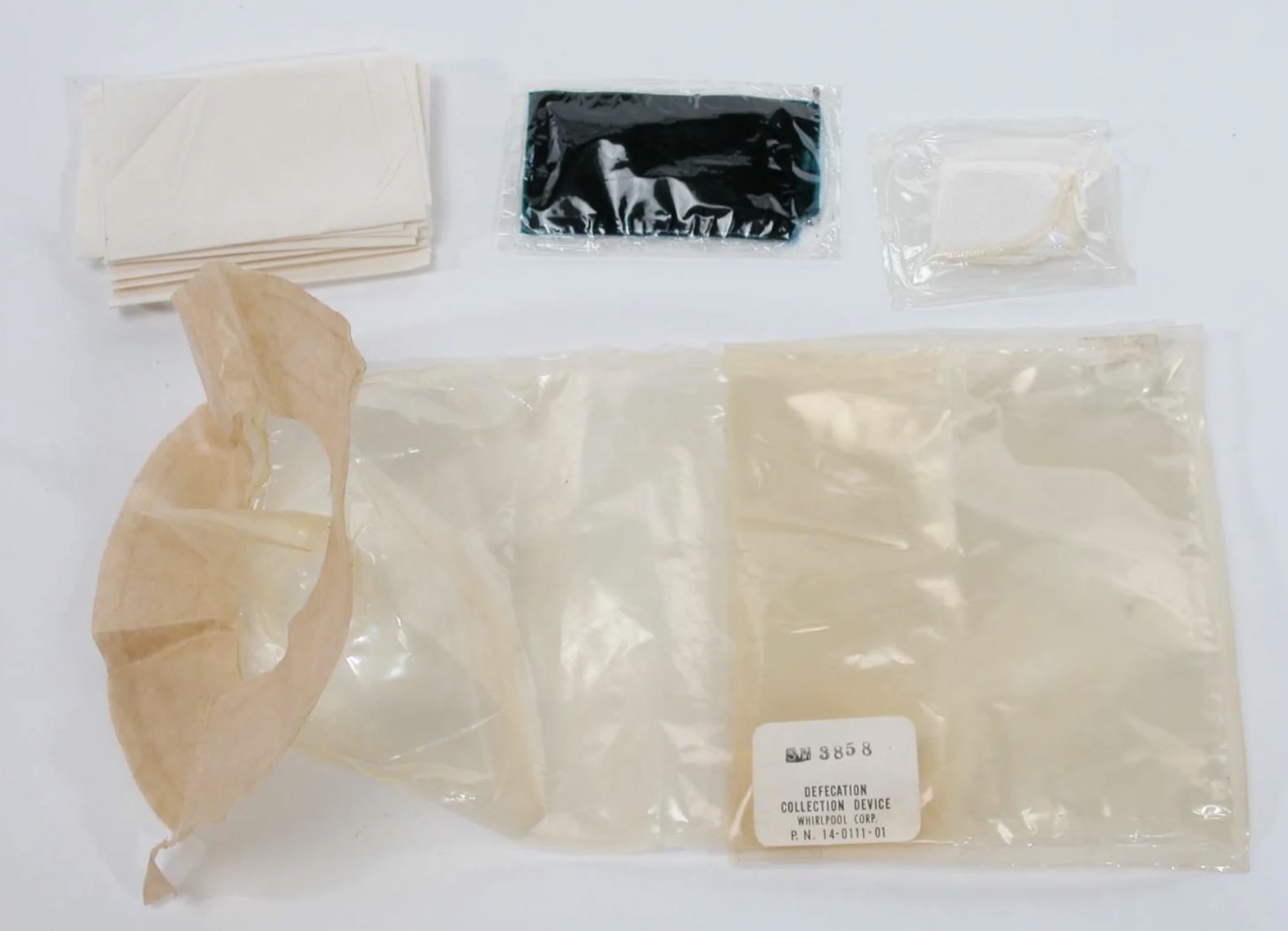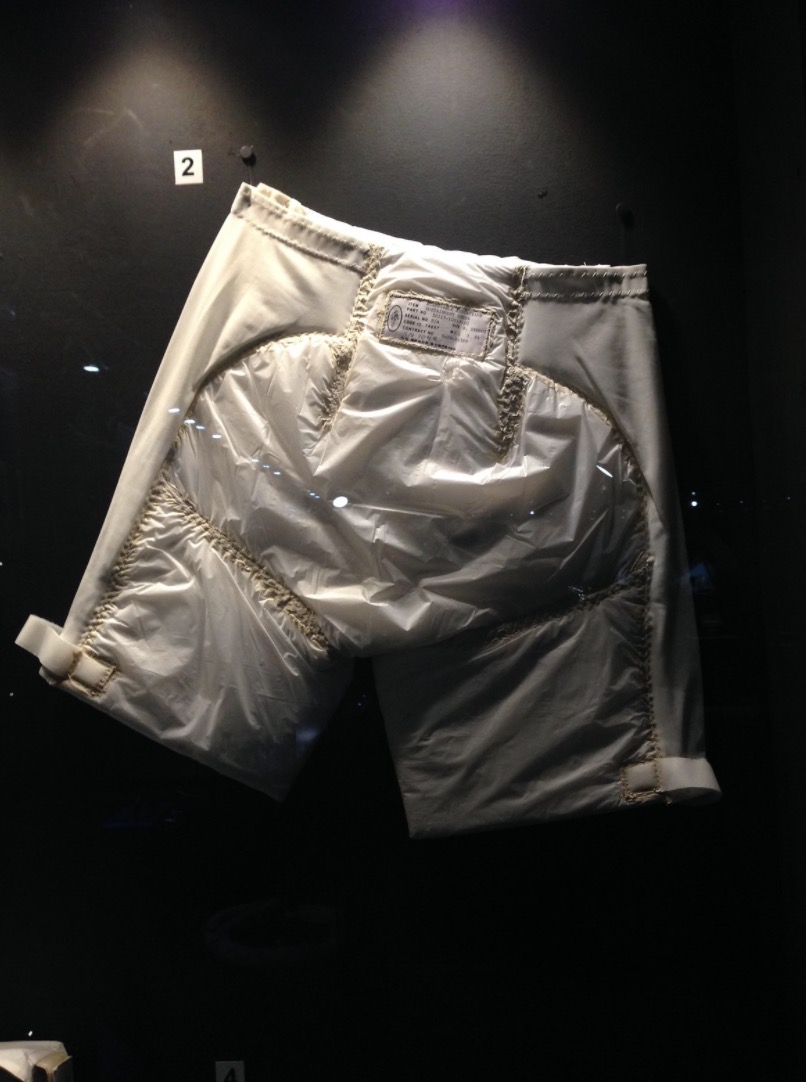This past weekend, the world observed the 50th anniversary of the Apollo 11 moon landing, the first time a human being ever set foot on the moon. Even fifty years later, we’re still in awe of what Neil Armstrong, Buzz Aldrin, Michael Collins, and hundreds of NASA employees accomplished. It’s easy to think of these space pioneers as mythical, larger-than-life figures. But they were very much human beings, just like you and me.
And do you know what’s a great way to humanize anybody, no matter how legendary? By learning about their bathroom habits. And so, today, in honor of the moon landing, we’re going to learn about an often overlooked but still essential part of the Apollo program: how the astronauts went to the bathroom.
Credit goes to author Mary Robinette Kowal, who has studied astronaut bathroom engineering in depth, particularly how it relates to gender. Recently, she published an essay in the New York Times titled “To Make It to the Moon, Women Have to Escape Earth’s Gender Bias.” Many uninformed internet commenters, (aka “internet commenters”) objected to the very idea that a woman could walk on the moon, arguing that biological differences make it impossible.
And so, to set the record straight, Kowal published an epic Twitter thread in which she broke down how NASA planned for astronauts to go to the bathroom, and what happened once these plans were put into action.
Let’s get to it!
Let’s talk about peeing in space.
Several people, in response to my NY Times essay, have said that women couldn’t go into space because we lacked the technology for them to pee in space.
— Mary Robinette Kowal (@MaryRobinette) July 19, 2019
Astronaut Alan Shepard was the first American to travel into space, via NASA’s first human spaceflight program, Project Mercury. Unfortunately for Mr. Shepard, Project Mercury did not have a plan for what to do in case nature called. Which nature did.
When Alan Shepherd became the first American man to go into space, it was scheduled to be a fifteen-minute mission.
Up.
Hello space!
Back down.
They made no plans for peeing.
— Mary Robinette Kowal (@MaryRobinette) July 19, 2019
Launchpad delays meant that Shepherd hit a point where he needed to go. Badly.
He asked Mission Control for permission to go in his suit. After consultation with flight surgeons & suit technicians, they gave him permission to do so.
So he wet himself & still went into space.
— Mary Robinette Kowal (@MaryRobinette) July 19, 2019
That detail probably didn’t make it into many history books.
Shepard’s accident forced NASA to come up with a plan, and they invented the Urine Collection and Transfer Assembly (UCTA), aka “the pee condom.”
Later, they solved this problem by developing a sheath, that looked much like a condom.
It worked great in testing, but when the actual astronauts used it, the sheath kept blowing off and leaving them with pee in their suits.
Was this about extended time in the spacesuit?
— Mary Robinette Kowal (@MaryRobinette) July 19, 2019

Photo Credit: Youtube
The sheaths came in small, medium, and large. It turns out, the men were all saying that they needed a Large sheath.
They did not.
Subsequently, the astronauts called the sheaths were called “Extra-large,” “Immense,” and “Unbelievable.”
— Mary Robinette Kowal (@MaryRobinette) July 19, 2019
Alas, even the best and the brightest are not immune to insecurity about the size of their “lunar module.”
Right now you’re probably thinking, “This information about peeing in space is great, but what about pooping in space?” Don’t worry! Kowal covered that, too.
They had to tape a bag to their ass to poop.
That worked well for Gemini and Mercury. And by well, I mean there was still urine in the capsule and it stank of feces.
Apollo needed a different solution.
— Mary Robinette Kowal (@MaryRobinette) July 19, 2019

Photo Credit: Smithsonian Air And Space Museum
And here’s a delightful photo demonstrating how to use the bag.

Photo Credit: NASA
What’s with the two fingers? Sorry in advance for being gross, but due to the lack of gravity in space, an astronaut’s poop does not simply fall out like it would on Earth. Manual intervention is necessary.
For the earliest space missions, pee condoms and adhesive poop bags were the solution to astronauts’ bathroom needs. However, the solution was far from perfect. Plenty could still go wrong, and it did. Like when the astronauts had to get the waste out of the space capsule.
Alas, they still had to poop into a bag, but for peeing, they could slip on a condom attached to a valve, turn the valve and have their urine sucked into the vacuum of space.
If you timed it right.
— Mary Robinette Kowal (@MaryRobinette) July 19, 2019
Open the valve a fraction too late, and urine escaped to float around the cabin.
Open it too early and the vacuum of space reached through the valve to grab your manhood.
Apparently, the venting of pee into space is very pretty. It catches the sunlight and sparkles.
— Mary Robinette Kowal (@MaryRobinette) July 19, 2019
Eliminating waste in space is difficult under ideal circumstances, but during the ill-fated Apollo 13 mission, it let to health problems for astronaut Fred Haise.
During Apollo13, everyone who has seen the movie knows that Fred Haise got sick. Do you know why, though?
After the accident, they couldn’t use the regular vent, because it needed to be heated to keep the pee from freezing.
— Mary Robinette Kowal (@MaryRobinette) July 19, 2019
The alternate system caused droplets to float around the ship. Mission Control told them to stop dumping pee.
It wasn’t meant to be a permanent ban, but the crew didn’t understand that. So they were stashing pee in every bag or container possible.
— Mary Robinette Kowal (@MaryRobinette) July 19, 2019
The fastest option was to store it in the collection bags they wore in their suits. Haise kept his on for hours and hours, basically bathing in pee.
He got a UTI and then a kidney infection.
— Mary Robinette Kowal (@MaryRobinette) July 19, 2019
And then there was the Apollo 10 mission, which really should be renamed “the one with floating poop.” Here’s a real excerpt from the mission transcript, which is probably the best thing you will ever read:
Cernan: “Where did that come from?”
Stafford: “Get me a napkin quick. There’s a turd floating through the air.”
Young: “I didn’t do it. It ain’t one of mine.”
Cernan: “I don’t think it’s one of mine.”
Stafford: “Mine was a little more sticky than that. Throw that away.”
Young: “God Almighty” (laughter)
In 1978, NASA finally opened up the space program to female applicants, and an alternative to the pee condom was necessary.
Finally, a decade later, NASA decides to send women into space. NOW they have a reason to come up with how to handle peeing in space if you don’t have a penis.
To launch and for a spacewalk, they developed the MAG
Maximum Absorbency Garment.
It’s a diaper.
— Mary Robinette Kowal (@MaryRobinette) July 19, 2019

Photo Credit: Flickr
The Maximum Absorbency Garment was so effective that the male astronauts switched over to it!
The men switched over to using those because it was more comfortable and less prone to leave pee floating around the cabin than the condom sheath.
They also developed a zero-G toilet so that astronauts no longer had to tape a bag to their ass.
— Mary Robinette Kowal (@MaryRobinette) July 19, 2019
Astronaut bathroom technology has progressed since the 1960’s and 70’s, but it still isn’t foolproof. Kowal went on to detail the bathroom problems facing contemporary astronauts.
Peeing or pooping in space is now a lengthy process, involving a fan, a targeting system, and a fair amount of prayer.
Fun pooping in space fact: Without gravity, the poop doesn’t break off as it exits your body. You have to reach back and help with special gloves.
— Mary Robinette Kowal (@MaryRobinette) July 19, 2019
During a malfunction, it is also possible for a giant floating globe of pee to exit the toilet.
Fun fact: Due to chemicals, it is bright purple and acidic.
Fun fact: Poop regularly escapes, which is why you never eat a milk dud found floating in the ISS.
— Mary Robinette Kowal (@MaryRobinette) July 19, 2019
During a malfunction, it is also possible for a giant floating globe of pee to exit the toilet.
Fun fact: Due to chemicals, it is bright purple and acidic.
Fun fact: Poop regularly escapes, which is why you never eat a milk dud found floating in the ISS.
— Mary Robinette Kowal (@MaryRobinette) July 19, 2019
All of which is to say that the reason women didn’t go into space had nothing to do with lacking the technology to pee.
We didn’t have the technology for men to pee in space when they started either.
And some days, the best solution is still a diaper or a bag taped to the ass
— Mary Robinette Kowal (@MaryRobinette) July 19, 2019
But wait! There’s more! What about other bodily functions? Kowal covered those, too. First up, the gassy ones.
Addendum with some FAQs:
What about Farting in space? – It does not propel you. Astronauts have tried.What about belching? – Gravity keeps food at the bottom of the stomach. Burps in space tend to be accompanied by solid matter
— Mary Robinette Kowal (@MaryRobinette) July 19, 2019
Up next, menstruation.
What about periods in space? – According to women who have been there, “It’s just like a period on Earth.”
It turns out menstrual blood moves via a wicking action. Gravity can speed that up, but is unnecessary.
Also, tampons exist.
— Mary Robinette Kowal (@MaryRobinette) July 19, 2019
Fun fact: When Sally Ride was preparing to go into space, NASA engineers asked her if 100 tampons would be the right number for a week.
She said, “No. That would not be the right number.”
They cut it back to 50…
— Mary Robinette Kowal (@MaryRobinette) July 19, 2019
Wow. Even literal rocket scientists are clueless when it comes to women’s health.
Finally, “morning wood.” Which, incredibly, does still happen in space despite the lack of a traditional day-night cycle!
FAQ: Erections in space? Officially, it’s never happened.
However, according to Mike Mullane in his book, Riding Rockets, he woke most mornings on the shuttle with his “wooden puppet friend”
“I had an erection so intense it was painful. I could have drilled through kryptonite.”
— Mary Robinette Kowal (@MaryRobinette) July 19, 2019
So there you have it! Everything you ever wanted to know about astronaut pee and poop. If you enjoyed this article, you should buy Kowal’s book, The Fated Sky: A Lady Astronaut Novel here.
The next time you look up to the stars, maybe you’ll appreciate how much the astronauts had to go to through to achieve the impossible. Just be careful not to look too long, because you might get splashed in the face by falling astronaut pee.
h/t: Bored Panda and Jalopnik
